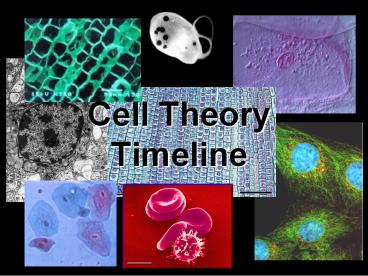Cell Theory Timeline PowerPoint PPT Presentation
1 / 24
Title: Cell Theory Timeline
1
Cell Theory Timeline
2
What is a cell?
- The basic unit of structure and function of life.
3
How do cells carry out life processes?
- Regulates what enters and exits the cell
- Helps the cell obtain and metabolize nutrients
(ENERGY) - Involved in growth and reproduction
- Involved in protein synthesis and
modifying/shipping proteins - Stores and digests nutrients/ digests harmful
chemicals - Provides structure for the cell and mobility
4
How can we view cells?
5
1665 Robert Hooke
- Builds compound microscopes and first to observe
cork cells.
6
Late1600s Anton van Leeuwenhoek
- Builds simple, powerful microscopes
- Observes many single celled organisms, (like
blood cells, animal sperm cells, bacteria from
his own teeth! He called them animalcules )
7
- 1855 Virchow
- Concludes that all cells come from pre-existing
cells
8
Cell Theory
- All organisms are composed of one or more cells.
- Cells are the basic units of structure and
function in an organism. - Cells come only from the reproduction of existing
cells.
9
Light Microscope
- Uses light to produce enlarged image
- Light rays bend when passing through lens
- Simple microscope magnifying glass
- Compound microscope 2 lenses
- Multiply the magnification of each lens to get
the total magnification.
10
Onion Cells
11
(No Transcript)
12
Electron Microscope
- First microscope constructed in 1931
- Higher magnification (up to 2 million times)
- Scanning electron microscopy can create 3-D
shapes - Expensive and large
- Image is not in color
- Sample must be dry (cannot view living organisms)
13
Fluorescent Microscopy
Principle of Fluorescence1. Energy is absorbed by the atom which becomes excited.2. The electron jumps to a higher energy level.3. Soon, the electron drops back to the ground state, emitting a photon (or a packet of light) - the atom is fluorescing.
14
Cell Diversity
- Shape There are many cell shapes. The function
of the cell influences the shape of the cell. - For example, skin cells are flat, nerve cells
have extensions.
15
Skin Cells
Nerve cell
16
Size
- Different types of cells have different sizes.
- 0.1 µm 100 µm
- The size of a cell is limited by the surface
area-to volume ratio.
17
Surface area-to-volume Ratio
larger
- As the cell gets ______, the surface-area-to-volum
e ratio gets _________. - If the cell grows beyond a certain limit, not
enough material will be able to cross the
membrane fast enough to provide for the increased
volume.
smaller
18
Surface area-to-volume ratio
Length of side Surface Area Volume Surface Area/ Volume
1
2
4
6
1
6
8
3
24
96
64
3/2 1.5
19
Surface area-to-volume ratio
- Materials must enter through the surface.
- The bigger the cell, the smaller the surface
area-to-volume ratio. - If a cell is too large, there is not enough
surface area to allow materials to pass through
quickly enough.
20
Types of Cells
- Prokaryotic vs. Eukaryotic
21
Prokaryotic Cells
22
- Very simple cell
- Generally smaller
- NO membrane-bound organelles (compartments)
- No true nucleus.
- DNA is found in the nucleoid region and is NOT
separated by a membrane. - Example is bacteria.
23
Eukaryotic Cell
24
- More complex cells
- Generally bigger
- Contains membrane-bound organelles
- Has a true nucleus
- Region of where DNA is stored and is separated by
a membrane. - Examples are animals plants

